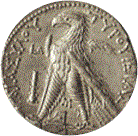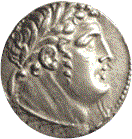

|
modern Tyre (Sour)
tied
to the mainland |
Ancient Western Semitic: Tsor ["rock" or "fortress"].
Phoenician city about 30 miles north of Ptolemaïs, built on a rocky island that Alexander the Great connected to the mainland with a half-mile causeway (4th c. BCE). As the first Canaanite city to attain independence from Egypt (12th c. BCE) it took the lead in the Phoenician colonization of the Mediterranean including the founding of Carthage (9th c. BCE).Tyrian purple dye from shellfish was so-highly prized in ancient times that it gave these seafaring traders their name: Phoenician ["purple people"]. Hiram (mid-10th c. BCE) built a breakwater that gave Tyre the best harbor on the eastern Mediterranean coast & established a mutually beneficial trade-alliance with David & Solomon. Hiram supplied the craftsmen & cedar wood for the temple at Jerusalem & other building projects of Solomon. But a century later the marriage of Jezebel, the daughter of Eshba'al of Tyre, to Ahab provoked a cultural crisis in Israel that challenged Mosaic tradition & led Elijah to launch a holy war.
Tyre's island location made it hard for ancient empires to subdue, until Alexander conquered it (333 BCE). Under Hellenistic & Roman empires, Tyre continued to flourish. Tyrian silver coinage was so pure that it was the only currency accepted in the temple at Jerusalem. According to the synoptic gospels [Mark 7], Jesus traveled through the region around Tyre & found supporters among its inhabitants. According to Acts 21, Paul landed there & stayed with local Christians on his way to Jerusalem.
Arch on old Roman road from Necropolis south of center of Tyre
(from photo by Børre Ludvigsen in Al Mashriq: The Levant)
For further recent information about archaeological & historical evidence, see: |
![]()
 |
 |
|
![]()
![]()
![]() Perspective on the
World of Jesus
Perspective on the
World of Jesus ![]()
Copyright © 1999-2023
by
Mahlon H. Smith
All rights reserved.
an American Theological Library Association Selected Religion Website
OCLC catalog no.: 62046512